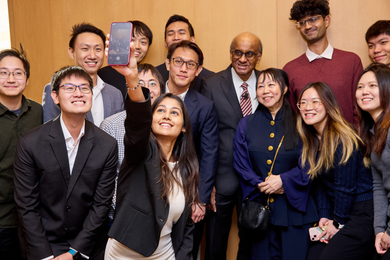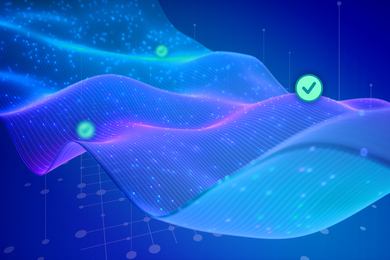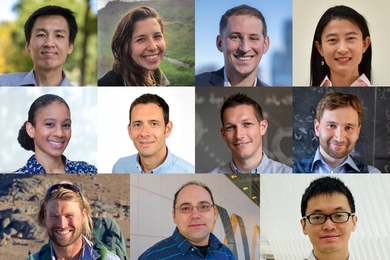Ordered patterns of gold nanoparticles on a silicon base can be stimulated to produce collective electron waves known as plasmons that absorb only certain narrow bands of light, making them promising for a wide range of arrays and display technologies in medicine, industry, and science.
Materials Processing Center (MPC)-Center for Materials Science and Engineering (CMSE) Summer Scholar Justin Cheng worked this summer in MIT professor of electrical engineering Karl K. Berggren’s Quantum Nanostructures and Nanofabrication Group to develop specialized techniques for forming these patterns in gold on silicon. “Ideally, we’d want to be able to get arrays of gold nanoparticles to be completely ordered,” says Cheng, a rising senior at Rutgers University.
“My work deals with the fundamentals of how to write a pattern using electron-beam lithography, how to deposit the gold, and how to heat up the substrate so we can get completely regular arrays of particles,” Cheng explains.
In MIT’s NanoStructures Laboratory, Cheng wrote code to produce a pattern that will guide the dewetting of a thin gold film into nanoparticles, examined partially ordered grids with an electron microscope, and worked in a clean room to develop a polymer resist, spin coat the resist onto samples, and plasma clean the samples. He is part of a team that includes graduate student Sarah Goodman and postdoctoral associate Mostafa Bedewy. He was also assisted by the NanoStructures Lab manager James Daley.
“Plasmons are collective oscillations of the free-electron density at the surface of a material, and they give metal nanostructures amazing properties that are very useful in applications like sensing, optics and various devices,” Goodman explained in a presentation to Summer Scholars in June. “Plasmonic arrays are very good for visible displays, for example, because their color can be tuned based on size and geometry.”
This multi-step fabrication process begins with spin coating hydrogen silsesquioxane (HSQ), which is a special electron-beam resist, or mask, onto a silicon substrate. Cheng worked on software used to write a pattern onto the resist through electron-beam lithography. Unlike some resists, HSQ becomes more chemically resistant as you expose it to electron beams, he says. The entire substrate is about 1 centimeter by 1 centimeter, he notes, and the write area is about 100 microns (or 0.0001 centimeter) wide.
After the electron-beam lithography step, the resist is put through an aqueous (water-based) developer solution of sodium hydroxide and sodium chloride, which leaves behind an ordered array of posts on top of the silicon layer. “When we put the sample in the developer solution, all of the less chemically resistant areas of the HSQ mask come off, and only the posts remain,” Cheng says. Then, Daley deposits a gold layer on top of the posts with physical vapor deposition. Next, the sample is heat treated until the gold layer decomposes into droplets that self-assemble into nanoparticles guided by the posts.
Solid-state dewetting
A key underlying materials science phenomenon at work in this self-assembly, Cheng says, is known as solid-state dewetting. “Self-assembly is a process where you apply certain conditions to a material that allow it to undergo a transformation over a large area. So it’s a very efficient patterning technique,” Goodman explains.
Because of repulsive interaction between the silicon and gold layers, the gold tends to form droplets, which can be coaxed into patterns around the posts. The Berggren group is working collaboratively with Carl V. Thompson, the Stavros Salapatas Professor of Materials Science and Engineering and the director of the Materials Processing Center, who is an expert in solid-state dewetting. Using a scanning electron microscope, Cheng examines these patterns to determine their quality and consistency. “The gold naturally forms droplets because there is a driving force for it to decrease the surface area it shares with the silicon. It doesn’t look completely ordered but you can see beginnings of some order in the dewetting,” he says, while showing an SEM image on a computer. “[In] other pictures you can clearly see the beginnings of patterning.”
“When we take the posts and we make them closer together, you can see that the gold likes to dewet into somewhat regular patterns. These aren’t completely regular in all cases, but for certain post sizes and spacings, we start to see regular arrays. Our goal is to successfully fabricate a plasmonic array of ordered, monodisperse [equally sized] gold nanoparticles,” Cheng says.
Goodman notes that Thompson's group has demonstrated exquisite control over dewetting in single crystalline films at the micron scale, but the Berggren group hopes to extend this control down to the nanoscale. “This will be a really key result if we’re able to bring this dewetting that’s beautifully controlled on the micro scale and enable that on the nanoscale,” Goodman says.
Cheng says that during his summer internship in Berggren’s lab, he learned to operate the scanning electron microscope and learned about nanofabrication processes. “I have learned a lot. Aside from the lab work that I’m doing, I’ve been scripting for the [LayoutEditor] CAD program that I use, and I’ve been using Matlab, too,” he says. “I actually learned a lot about image analysis because there are a lot of steps that go into image analysis. Since we have so much data and so many images to analyze, I’m doing it quantitatively and automatically to make sure I have repeatability.”
MPC and CMSE sponsor the nine-week National Science Foundation Research Experience for Undergraduates (NSF REU) internships, with support from NSF’s Materials Research Science and Engineering Centers program. The program ran from June 7 through Aug. 6.











